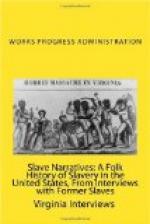The Willis family did not object to girls and boys courting. There were large trees, and often in the evenings the boys from other plantations would come over to see the girls on the Willis plantation. They would stand in groups around the trees, laughing and talking. If the courtship reached the point of marriage a real marriage ceremony was performed from the Bible and the man was given a pass to visit his wife weekly. Following a marriage a frolic took place and the mistress saw to it that everyone was served nice foods for the occasion.
Frolics were common occurrences on the Willis plantation, also quilting parties. Good foods consisting of pies, cakes, chicken, brandied peaches, etc. “Dancing was always to be expected by anyone attending them,” remarked Mrs. Callaway. “Our master always kept two to three hundred gallons of whisky and didn’t mind his slaves drinking. I can remember my master taking his sweetened dram every morning, and often he gave me some in a tumbler. On Christmas Day big dinners were given for all of the slaves and a few ate from the family’s table after they had finished their dinner.”
Medical care was promptly given a slave when he became ill. Special care was always given them for the Willis family had a personal interest in their slaves. “On one occasion,” remarked Mrs. Calloway, “the scarlet fever broke out among the slaves and to protect the well ones it became necessary to build houses in a field for those who were sick. This little settlement later became know as “Shant Field.” Food was carried to a hill and left so that the sick persons could get it without coming in contact with the others. To kill the fever, sticks of fat pine were dipped in tar and set on fire and then placed all over the field.”
Religion played as important part in the lives of the slaves, and such [TR: much?] importance was attached to their prayer meetings. There were no churches, provided and occasionally they attended the white churches; but more often they held their prayer meetings in their own cabins. Prayers and singing was in a moaning fashion, and you often heard this and nothing more. On Sunday afternoons everyone found a seat around the mulberry tree and the young mistress would conduct Sunday School.
Concerning the Civil War, Mrs. Callaway related the following story:




